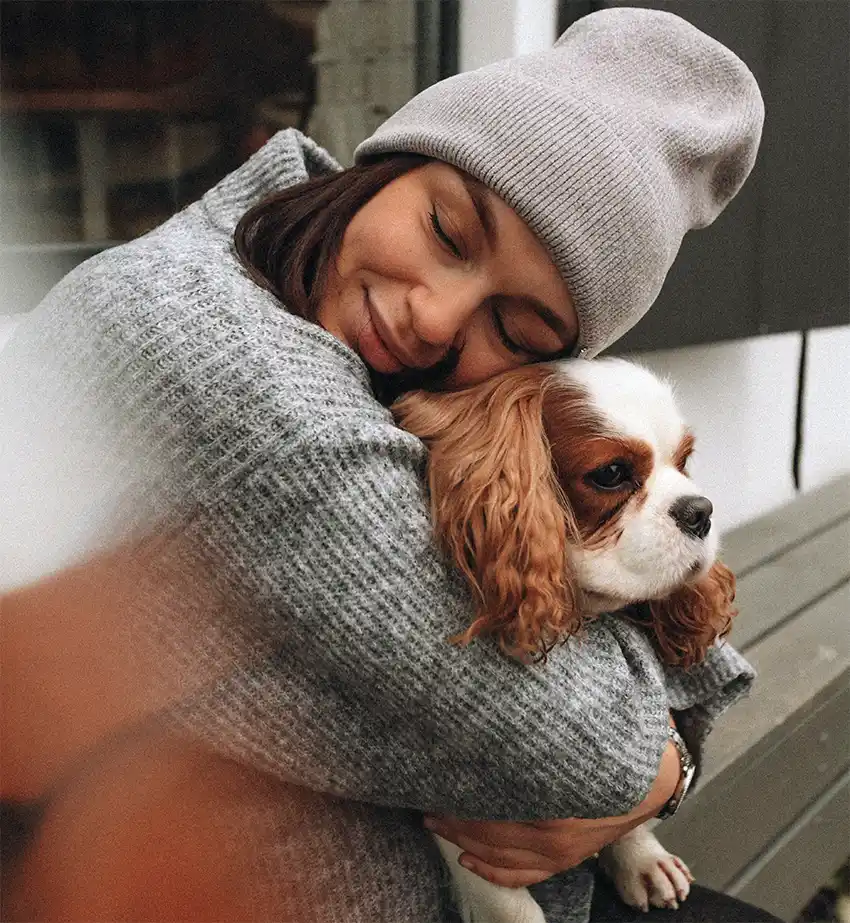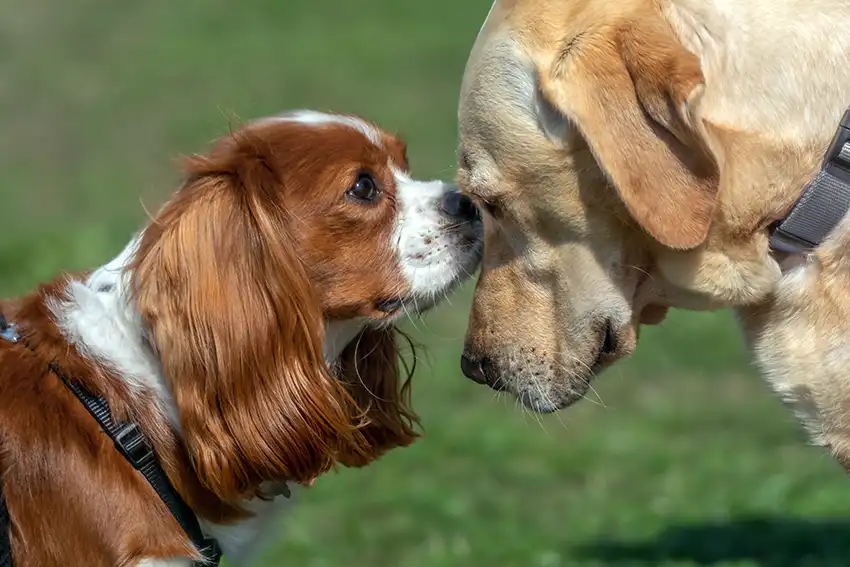The Cavalier King Charles Spaniel is ranked among the top 20 most popular breeds globally, largely due to its stable personality, loving way, and appealing looks. The breed is an ideal family or companion dog. Originating in the United Kingdom this breed has a long noble history. The Cavalier King Charles is classed as a 'toy' breed and is one of the smallest Spaniels. A compact little dog which can make an excellent travel companion.
Physical Characteristics
The Cavalier King Charles Spaniel is one of the smallest spaniels. The breed has short legs, a lustrous coat, long ears, and a natural long feathered tail. Cavalier King Charles Spaniels have an appealing look with a kind face that will instantly win your heart.
The quintessential lap dog is small as far as Spaniels go, with fully grown adults comparable in size to adolescents of other larger spaniel breeds.
A Cavalier King Charles has a muzzle and a more elongated face, which should not be confused with the King Charles Spaniel, that has a flat 'human like' face.
The breed has four main coat colours including, "black and tan", "chestnut and white" known as the 'Blenheim'), "black", "white and tan", and a deep "red or ruby" colour, referred to as Ruby.
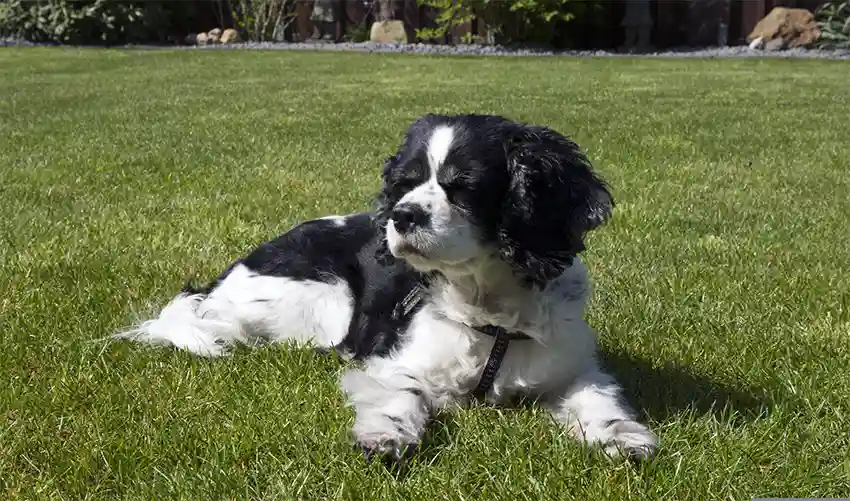
History
The Cavalier King Charles Spaniel and the King Charles, or English Toy Spaniel, are often confused. The two breeds share similar history and only diverged approximately 100 years ago.
There are several differences between the two breeds, however the primary difference is size. The Cavalier’s average weight is between 5.9 to 8.2 kgs. The King Charles is slightly smaller averaging 4.1 to 6.8 kgs. With similar facial features, the Cavalier's ears are set higher and its muzzle length longer. The Cavalier’s skull is flatter while the King Charles's has a domed skull.
During the 18th century, John Churchill, 1st Duke of Marlborough, kept chestnut and white coloured King Charles Spaniels, which were used for hunting. The Duke recorded that they were able to keep up with a trotting horse. The Dukes estate was called "Blenheim" after the Battle of Blenheim. Thus, chestnut and white Cavalier King Charles Spaniels and King Charles Spaniels soon became known as “Blenheim” coloured.
Personality and Temperament
In our opinion, The Cavalier King Charles has one of the most stable temperaments of all the toy breeds. Generally, this breed has a loving and easy-going personality and is outgoing and usually sociable with other dogs.
Most Cavalier King Charles Spaniels have few behaviour or training problems and those we have been called in to help are most often where the dog has been over-indulged and received no form of basic education or proper socialisation. In most cases, these issues are easily turned around and we have dog and human communicating in no time.
Separation Anxiety
Separation Anxiety is one issue that is occasionally found in this breed as well as nuisance barking, especially when left alone. This can stem from the fact that they are so adorable and loving, that you never want to leave them alone! This breed is very social and a great family dog, but you also must train your dog so that it may be able to be left alone without acting up or feeling anxious.
If your dog is always accustomed to being with you, when you need go out it may cause your puppy some stress. Consider setting some rules and be sure to teach separation with your dog, even when you're at home.

You don't have to use our list, set your own rules that work in your household and then stick to them, and your Cavalier will be a better version of themself.
Grooming
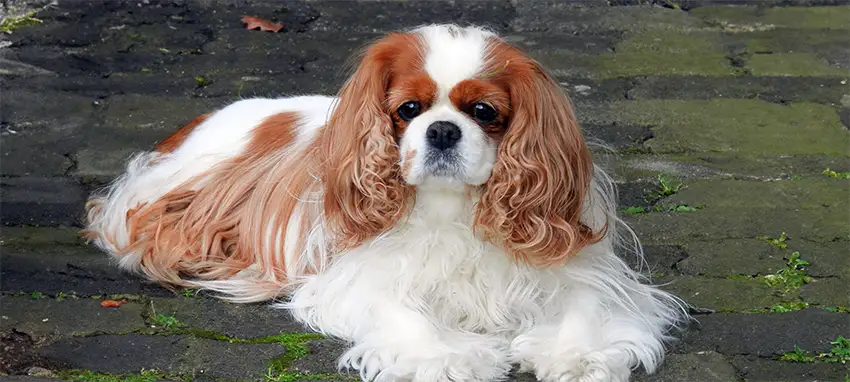
The Cavalier King Charles Spaniel is an easy dog to care for and to groom. Cavaliers do shed, particularly in the spring and autumn, but not as much as other breeds with thick undercoats. The benefit of their coat is that they do not require regular clipping like a poodle or associated breeds.
Regular brushing and an occasional bath are all that is required to keep the Cavalier King Charles clean and looking its best.
Remember that too much bathing will strip your dog's coat of its natural oils. A warm wet towel wiped over your dog, can be used in between washes to keep them looking fresh and clean.
If your Cavalier King Charles has that 'doggy smell' do not assume your dog needs a bath, it might be a sign of a skin condition or allergic reaction. For example, eczema has a distinctive pungent smell. Speak with your veterinarian for the best treatment for your dog. We also recommend researching the cause of any skin problems, as there will be a reason behind why your dog is having skin issues. Treat the problem but more importantly treat the cause!
Training Your Cavalier King Charles Spaniels

Who can resist Cavalier King Charles Spaniels? They are sweet, beautiful little dogs that can fit into almost any lifestyle and are usually great with children and other animals. They can be great dogs for people who have never had a dog before. As with any dog, they need an education, and we need to understand how the dog's mind works
1. Dogs will repeat behaviour that rewards them. This can be a challenge with Cavalier King Charles Spaniels for the simple reason that they are so adorable. I like to read the paper in the morning while I have my coffee and toast. Imagine Charley, a cute little Cavalier puppy, coming over and putting his paws on my leg to get attention. If I put my paper and coffee down and reach down to pet Charley and give him a piece of toast, I have rewarded his attention seeking behaviour and his demand for my toast. I am teaching him that it's ok to interrupt me and demand toast and attention. It might not be a big deal right now but there will be times when it will be. Be careful when you reward a puppy and make sure you only reward good behaviour. Your attention and affections are probably the biggest rewards you typically can give a dog.
Puppies and dogs learn very quickly about the things we enjoy doing with them, and they make it easy for us to respond to them by asking us to do the things we enjoy. When we do respond to their sweet requests, dogs will take it to mean we are doing their bidding. When this happens, they will often start making other decisions, based on their canine perceptions and understanding. These decisions rarely align with our decisions and will end up in trouble.
2. Dogs speak their own language. Dogs can learn words and it's not uncommon for them to learn to associate over 100 words, with some dogs learning over 1000, but they really don't speak any human language. They speak their own canine language, which is a combination of body language, vocal tones (barks, cries, growls, howls etc.) and postures and actions. It is much easier for us to learn their language than for them to learn ours. Dogs will learn hand signals quicker than they will learn words because these are body language, which dogs are experts at reading and understanding. By combining hand signals with vocal cues, you can begin to teach your puppy some words, but dogs will never understand the nuances of human language. Bark Busters will teach you to "Speak Dog."
3. Dogs are not deliberately naughty or bad. They do things that either come naturally to them or that they have learned and things that will get reactions often get repeated. As with Charley coming over to interrupt my morning toast, coffee and paper reading, most likely if I didn't respond he would have found something else to do. If you come home from being out and find that your favourite quilt now has holes in it, your dog didn't do it because he was mad at you for going out without him. He may have been bored or he may have been stressed but he didn't do it to "get back at you". That is not in a dog's nature, although it might seem that way to us humans. Chewing is a natural dog behaviour as is digging. Dogs don't read or watch TV to occupy themselves, and if you don't give them something to occupy themselves to stave off boredom, they will find something to do on their own, which might not be what you want them to do.
Bark Busters are the world's experts at helping people teach their dogs how to become great family members. Founded in 1989, we have trained over one million dogs worldwide. Our experience and worldwide support guarantee is unmatched, and our life of the dog support guarantee gives you peace of mind knowing that additional help, and free of charge home visits, are only a phone call away, when they need it.
Puppy Selection
If you are looking for a Cavalier King Charles Puppy, we recommend you check all the Cavalier rescue organisations first, or, be sure you choose a reputable breeder. Animal shelters work hard to match the right owners with the right dogs, as it's not just about finding homes, it's about finding that 'forever home'.
Most dogs are abandoned for the wrong reasons and some people are not fully prepared to do what it takes to train and educate a dog. Shelters give their dogs health checks to make sure they are in good shape and up to date on vaccinations and will make you aware of any behaviour problems. Bark Busters trainers work with many local shelters to help overcome any behaviour problems before a dog is adopted.
A good breeder will try to screen out all the health problems inherent to the breed, as much as possible. They should be happy to answer your questions about temperament and health considerations and should ask you questions about your lifestyle and goals. Many breeders are registered with the Kennel Clubs, as well as local Cavalier King Charles Spaniel clubs and associations, where they abide by certain policies and screening.
Before you decide on a puppy, ask yourself if you would be better off with an adult Cavalier, that would mean lower maintenance and lower energy. Puppies are fun, but they are also a lot of work.
Whether you decide on a puppy or an adult dog, make sure you take your dog to the vet soon after adoption to identify and prevent any problems, and to check on its immunisation and de-sexing needs.
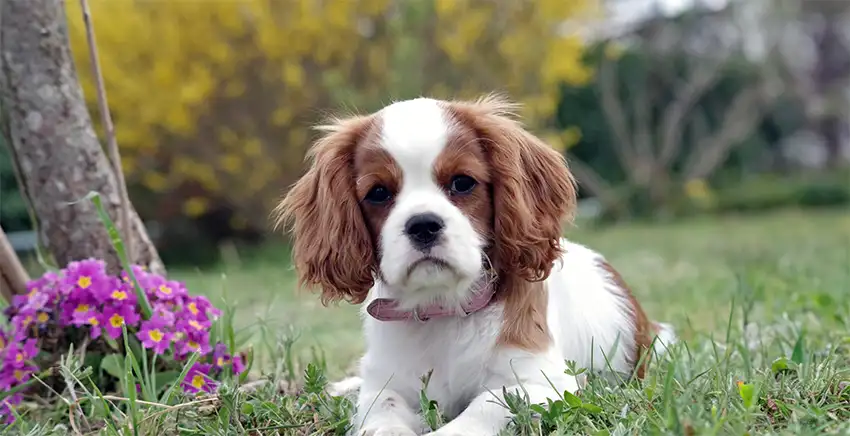
Select the right puppy. One that suits your lifestyle.
Many of our Bark Busters trainers volunteer their services at local shelters and rescues to assist in rehabilitating dogs. Bark Busters have saved many thousands of dogs through our volunteer rescue programmes around the world.
If you do decide to go to a breeder, then ensure you view both parents to determine the puppy’s personality and parentage.
View all interaction between the puppies as this will tell you a lot about their personality. Look out for those assertive types if you want a dog that is going to be good family dog that is good with children.
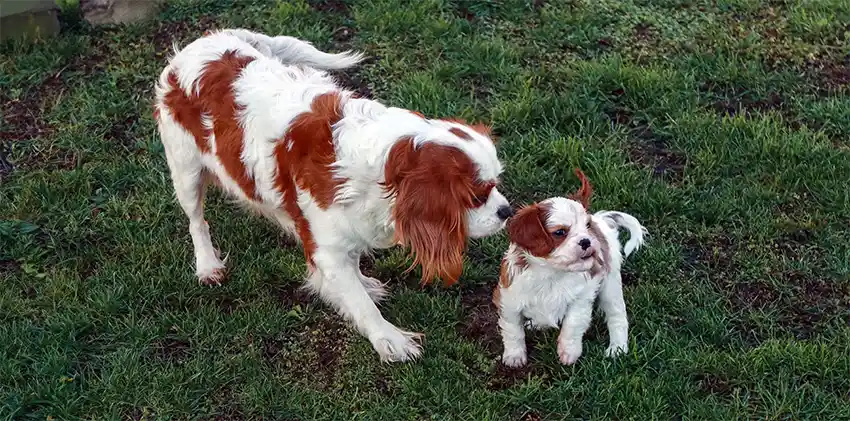
Tips for Bringing a New Puppy Home
Do not bring a puppy home before it has reached 8 weeks of age, but preferably 12 weeks. Any earlier and they will miss out on much needed bonding with other puppies and their mother.
Bring your puppy home early in the day to allow time for your puppy to settle into its new home.
Try to bring some bedding home with the scent of the mother dog, scent of other litter mates, or a familiar scent.
Ensure that you know where your puppy will sleep and introduce your puppy to this area during mealtimes.
If you need to leave your puppy alone for a short while, ensure that you address any barking, while hidden close by, without returning to the puppy. Returning every time your puppy demands, will only encourage more barking. Puppies do better if they know you are there nearby and have not deserted them.
Ensure you have the same diet that your puppy was being fed when with its mother. Any diet change must be a gradual one.
Ensure that you puppy proof your house and place anything dangerous out of harm's way, such as electrical cables and poisonous chemicals.
Make sure you provide lots of bathroom breaks. Take your puppy to do its business at least 8 times per day, after sleeping, eating, drinking and any exuberant exercise.
Do I Want One Dog or Two?
We are often asked by prospective dog parents if they should get one or two puppies. We always answer the same way. Get two only if you really want two dogs!
Dogs are pack animals, and they love having company, but the selection of two dogs is something that must be carefully thought through.
Two neutered males can cohabit without too many issues if their doggie parents treat them equally and do not display any favouritism. Unequal treatment is usually behind most Sibling Rivalry cases.
A male and a female of equal energy can also cohabit. This can be the best match, providing that the female and male are equally matched in size. If they are differing sizes, its best that the male is the larger of the two. Make sure that the female is neutered, when appropriate, or problems could occur if a large male tries to mate with a smaller female.
Two females are not always the perfect pair, as females invariably want to rule the household. It won’t be long before they test each other, and some females won't back down. When you have two females in a household, they both might try to be the boss of each other, which can lead to fights.
Toilet Training
Without a doubt, toilet training a puppy has its challenges and can try your patience. You need to be observant and begin as soon as the puppy is home with you. Bark Busters will make sure the process is not stressful for you or your puppy.
When puppies are first born, they relieve themselves in their den, but their mother is there to clean them. Therefore, there is no scent of urine or faeces where the puppies eat, sleep and play. As they get slightly older, they learn to imitate the mother when she goes outside. This way the puppy becomes conditioned to never eliminate in their dens. If you are crate training, you will find that puppies will avoid toileting in their crate at all costs.
Knowing when your puppy is likely to relieve themselves by reading their body language is the key to success.
Have you ever taken a puppy outside for a walk only to find they relieve themselves as soon as they get back indoors? To avoid this, walk the puppy directly to the area you have designated the toileting area. Stand still and stay with the puppy, so they no longer show interest in you. Do not sit down as this will only encourage the puppy to jump on you and forget what they are there for. Praise when they perform. NEVER scold or rub their nose in any mistakes. This is cruel and will teach your puppy to move out of sight or wait until you are not watching.
Your puppy does not possess human logic but will begin to form good habits through structured routines. Positive reinforcement when they do the right thing in the right place is the best and quickest toilet training method.
Four Basic Needs
Let's examine those four basic needs and why your dog needs them to keep it healthy, balanced and content.
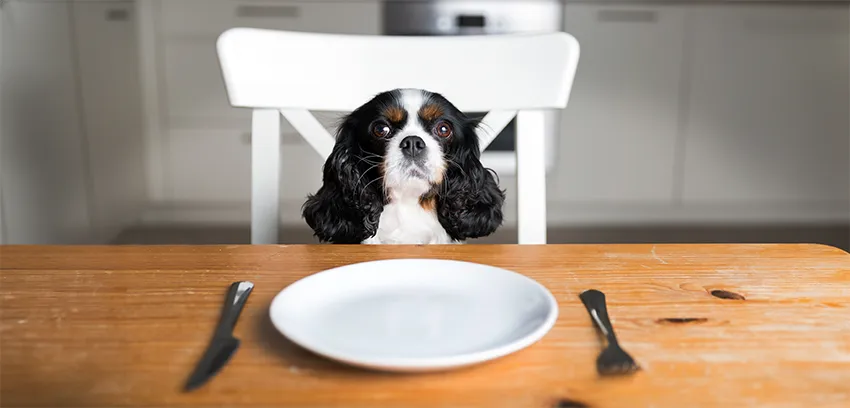
Food - diet / nutrition
Some dogs can be pretty picky about their food. Consult with your veterinarian about which brand of food you should purchase, or which raw diet is best for your dog. Your dog's diet is important to meet their nutritional needs and to maintain the overall health. For puppies, as they are so small, you don't need a lot of food to fill them up!
We promote a diet that is grain free, low in carbohydrates and without any harmful e-numbers, colours and preservatives. Carbohydrates do add energy that the dog needs to burn off and can make an already hyperactive dog more active.
The right diet, grain free and filled with fruits, vegetables and raw meat will have advantages to how your dog will feel, look and act.
If you want to understand why grains can make a dog more energetic, you only need to think of racehorses and how their trainers give them grain to get highly energetic racehorses. Energy in, equals energy out.
Bark Busters dog trainers are not vets or dietitians, so we urge you to do your own research into the best diet for your dog. A diet that you will be comfortable with.
We do however have vast experience of how highly concentrated grain diets effect behaviour and can cause hyperactivity. This is very prominent in Japan, where most dogs are fed high levels of rice in their diet which can adversely affect concentration and focus.
Safety - through leadership and education
All dogs need strong leadership and to know where they fit into the family unit. If they know they have a leader that will make all the decisions, one who is fair and just, they will be happy and content.
On the other hand, if they have no structure in their life, they have inconsistency, and don’t know how things will be from one day to the next, then they will become stressed and may experience health ailments, skin and stomach issues and behaviour problems. Routine and respect must be established. With equal doses of love and structure your dog will feel safe and secure.
Your dog just wants to please you but many times they don't know how. If you don't quickly establish yourself as the leader, your dog will gladly assume this role and chaos could follow.
Shelter - a place to call their own
Dogs love nothing better than to curl up on the couch or in a place they can call their own, even when there is more than one dog. Most dogs are very sociable, and they will think nothing of all snuggling in together. Provide your dog with its own "den", a place where they can call home, and somewhere they can go to for a bit of peace and quiet. Just make sure their "den" is warm, easy to clean and maintain. Also, this breed does not like to be cold, and their shivering is a sign that some warmth is needed.
Entertainment - toys & games
A very important part of your dog's four basic needs is their need to have something to do. If we want to avoid our pets becoming bored and destructive, then they need a way to fill their day.
Dogs thrive with physical and mental exercise. Dogs are highly intelligent animals, and they need to keep their brains active as much as their bodies. Entertainment is an important part of their well-being and essential to your dog's overall mental health.
One great toy is the Bark Busters GameChanger® which helps to prevent boredom, stress, and separation anxiety. By filling it with small treats, your dog will have plenty of fun trying to get the treats to dispense.

Games to Play
What are the right games, you might ask?
Don't play any games that involves rough and tumble as this only encourages biting.
'Tug of War' is okay and playing ball is good, provided your dog is not the type that gets fixated on the ball and refuses to stop playing when requested. Hide and seek is a great game too. These are games where you hide things from your dog, like toys or a tennis ball or treats and then encourage them to find them. You can increase the degree of difficulty as your dog gets better at the game.
Start out where your dog sees you hide the item, then repeat over and over, 'Seek' which is a good command to use for this exercise. Remember to give a lot of praise when they find it. These types of games are more calming for your Yorkie, than those type of games that encourage your dog to become over-excited or teaches them to bark or bite hands.
Child’s Play
Cavalier King Charles Spaniels need to be controlled when around babies or toddlers so as not to nip at them. They are intelligent and do learn quickly, so spend time educating them as to what is good and what is not. If you are patient and understanding of their capabilities, you will be able to enjoy many great times as a family with your dog.
Dog Parks
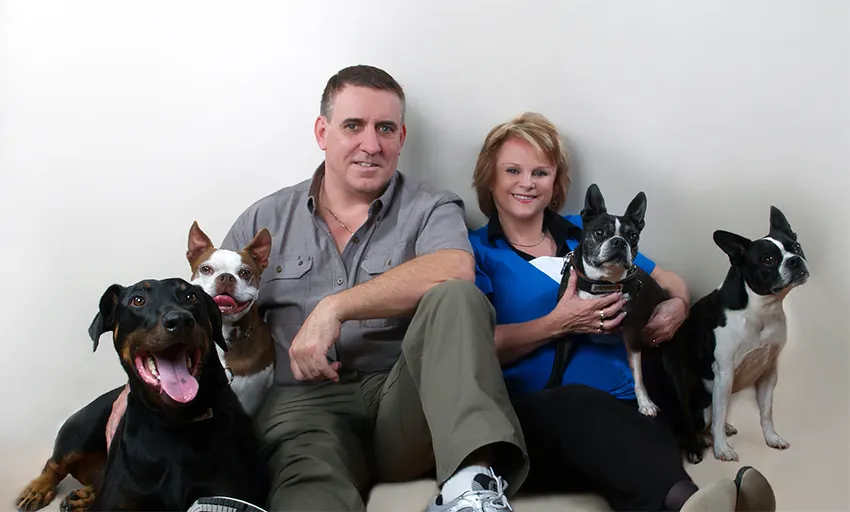
Danny and Sylvia Wilson, Founders of Bark Busters
Taking Your Cavalier King Charles Spaniel to Dog Parks
Dog Parks are one of the most misunderstood dog activities of the modern-day dog world. Some doggie parents love nothing more than to take their dog to a dog park. They have been told they need to socialise their dog and so off they go.
They love the fact that their dog has fun, they get to meet other dog lovers and watch the dog's romp around and play.
That is the upside, but the downside is there are those dog lovers whose dogs don't fit into this world at all. They are those dogs or puppies that were bullied, frightened on their first visit or whose personality does not fit the mould.
These folks agonise over the fact that their dog or puppy does not look forward to its trip there, it hides under the seat of the car, or it has to be carried or enticed into the park.
Many ask us why their dog acts like this and how they can fix it?
Bark Busters do have ways to assist these pet parents, but we do also explain why their dog might not like the dog park because of its personality.
It reminds us of a friend of ours who visited us regularly with her little dog, 'Harry'.
When they would arrive, Harry would walk up to each of us, sniff our legs and walk away.
She questioned us one day on why we never petted Harry when he came up to us.
We explained that this was not what Harry was doing, he was sniffing us, not requesting a pat. If he had been requesting to be petted, after sniffing us, he would have gestured to us to pet him. He did not do that, instead he walked away.
We told her that Harry was not a social dog and preferred not to be touched by anyone other than her and he avoided any interaction with our dogs too. He was a 'one person' dog that did not feel comfortable around others.
It was like a light had been turned on, our friend smiled and told us that this explained a lot to her. She further explained that every time she took Harry to the dog park, that he could not wait to get back to the car when it was time to leave, that he would stand away from the other dogs, never join in the play and snap at other dogs when they came near him.
He was telling her in every way he could that he did not fit into that dog park crowd, just like some humans hate parties!
Bark Busters Lifetime Support Guarantee
Bark Busters dog behaviour therapists and trainers have trained more than 1 Million dogs worldwide and are renowned authorities in addressing dog behaviour with all-natural, dog-friendly methods. The Bark Busters training is the only service of its kind to provide International dog training guaranteed lifetime support. With hundreds of trainers around the world, Bark Busters continues its mission to enhance the human/canine relationship and to reduce the possibility of maltreatment, abandonment and euthanasia. Contact your local Bark Busters dog trainer to see how they can help.
This article is the copyright of Bark Busters® and is intended for information purposes only. Dog owners should fully research any problems that they may have with their dogs.

